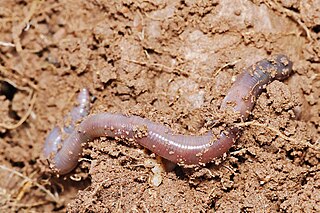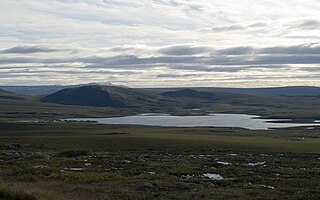Related Research Articles

An ecosystem consists of all the organisms and the physical environment with which they interact. These biotic and abiotic components are linked together through nutrient cycles and energy flows. Energy enters the system through photosynthesis and is incorporated into plant tissue. By feeding on plants and on one another, animals play an important role in the movement of matter and energy through the system. They also influence the quantity of plant and microbial biomass present. By breaking down dead organic matter, decomposers release carbon back to the atmosphere and facilitate nutrient cycling by converting nutrients stored in dead biomass back to a form that can be readily used by plants and microbes.

The Marine Biological Laboratory (MBL) is an international center for research and education in biological and environmental science. Founded in Woods Hole, Massachusetts, in 1888, the MBL is a private, nonprofit institution that was independent for most of its history, but became officially affiliated with the University of Chicago on July 1, 2013. It also collaborates with numerous other institutions.

A biogeochemical cycle, or more generally a cycle of matter, is the movement and transformation of chemical elements and compounds between living organisms, the atmosphere, and the Earth's crust. Major biogeochemical cycles include the carbon cycle, the nitrogen cycle and the water cycle. In each cycle, the chemical element or molecule is transformed and cycled by living organisms and through various geological forms and reservoirs, including the atmosphere, the soil and the oceans. It can be thought of as the pathway by which a chemical substance cycles the biotic compartment and the abiotic compartments of Earth. The biotic compartment is the biosphere and the abiotic compartments are the atmosphere, lithosphere and hydrosphere.

Detritivores are heterotrophs that obtain nutrients by consuming detritus. There are many kinds of invertebrates, vertebrates, and plants that carry out coprophagy. By doing so, all these detritivores contribute to decomposition and the nutrient cycles. Detritivores should be distinguished from other decomposers, such as many species of bacteria, fungi and protists, which are unable to ingest discrete lumps of matter. Instead, these other decomposers live by absorbing and metabolizing on a molecular scale. The terms detritivore and decomposer are often used interchangeably, but they describe different organisms. Detritivores are usually arthropods and help in the process of remineralization. Detritivores perform the first stage of remineralization, by fragmenting the dead plant matter, allowing decomposers to perform the second stage of remineralization.

Mangrove forests, also called mangrove swamps, mangrove thickets or mangals, are productive wetlands that occur in coastal intertidal zones. Mangrove forests grow mainly at tropical and subtropical latitudes because mangroves cannot withstand freezing temperatures. There are about 80 different species of mangroves, all of which grow in areas with low-oxygen soil, where slow-moving waters allow fine sediments to accumulate.
The Long Term Ecological Research Network(LTER) consists of a group of over 1800 scientists and students studying ecological processes over extended temporal and spatial scales. Twenty-eight LTER sites cover a diverse set of ecosystems. It is part of the International Long Term Ecological Research Network (ILTER). The project was established in 1980 and is funded by the National Science Foundation. Data from LTER sites is publicly available in the Environmental Data Initiative repository and findable through DataONE search.
F. Stuart Chapin III is a professor of Ecology at the Department of Biology and Wildlife of the Institute of Arctic Biology, University of Alaska. He was President of the Ecological Society of America (ESA) from August 2010 until 2011.

Human impact on the nitrogen cycle is diverse. Agricultural and industrial nitrogen (N) inputs to the environment currently exceed inputs from natural N fixation. As a consequence of anthropogenic inputs, the global nitrogen cycle (Fig. 1) has been significantly altered over the past century. Global atmospheric nitrous oxide (N2O) mole fractions have increased from a pre-industrial value of ~270 nmol/mol to ~319 nmol/mol in 2005. Human activities account for over one-third of N2O emissions, most of which are due to the agricultural sector. This article is intended to give a brief review of the history of anthropogenic N inputs, and reported impacts of nitrogen inputs on selected terrestrial and aquatic ecosystems.

Soil respiration refers to the production of carbon dioxide when soil organisms respire. This includes respiration of plant roots, the rhizosphere, microbes and fauna.
Deborah K. Steinberg is an American Antarctic biological oceanographer who works on interdisciplinary oceanographic research programs. Steinberg's research focuses on the role that zooplankton play in marine food webs and the global carbon cycle, and how these small drifting animals are affected by changes in climate.
Niwot Ridge is an alpine ecology research station located 65 km northwest of Denver in north-central Colorado. It is on the Front Range of the southern Rocky Mountains and lies within the Roosevelt National Forest. Niwot Ridge is 2,900 metres (9,500 ft) high.
Sarah E. Hobbie is an American ecologist, currently at the University of Minnesota, a National Academy of Sciences Fellow for Ecology, Evolution and Behavior in 2014 and a formerly Minnesota McKnight Land-Grant Professor.

Changing climate conditions are amplified in polar regions and northern high-latitude areas are projected to warm at twice the rate of the global average. These modifications result in ecosystem interactions and feedbacks that can augment or mitigate climatic changes. These interactions may have been important through the large climate fluctuations since the glacial period. Therefore it is useful to review the past dynamics of vegetation and climate to place recent observed changes in the Arctic into context. This article focuses on northern Alaska where there has been much research on this theme.

The viral shunt is a mechanism that prevents marine microbial particulate organic matter (POM) from migrating up trophic levels by recycling them into dissolved organic matter (DOM), which can be readily taken up by microorganisms. The DOM recycled by the viral shunt pathway is comparable to the amount generated by the other main sources of marine DOM.
Christine Goodale is an ecosystem ecologist and an Associate Professor in the Department of Ecology and Evolutionary Biology at Cornell University. Goodale conducts research that studies the cycling of water, carbon, nitrogen and other nutrients through forest ecosystems.

Tana Elaine Wood is a biogeochemist and ecosystem scientist with a focus in land-use and climate change. Her research is focused on looking into how these issues affect tropical forested ecosystems and particularly focuses on soil science and below ground research efforts.

Toolik Lake is an Arctic lake located within the North Slope Borough, Alaska. It is in a remote wilderness area managed by the Bureau of Land Management accessed by the Dalton Highway. It is 130 mi (210 km) south of Prudhoe Bay in the northern foothills of the Brooks Range. The name is derived from the Iñupiat word tutlik, meaning yellow-billed loon.
Carol Arlene Johnston is a Professor Emeritus in the Department of Natural Resource Management at South Dakota State University. Johnston is known for her research on beaver ecology and wetlands.
Michelle Cailin Mack is an ecologist working on the connections between plants and climate in polar regions. She is a fellow of the Ecological Society of America and the American Geophysical Union. She currently holds the title of Regent's Professor at Northern Arizona University.
Merritt Turetsky is an American ecosystem ecologist and a professor at the University of Colorado Boulder. She currently serves as the Director of Arctic Security for the University of Colorado. She served as the first woman Director of the Institute for Arctic and Alpine Research (INSTAAR) from 2019-2023. Her research considers fire regimes, climate change and biogeochemical cycling in Arctic wetlands. Turetsky is a member of the Permafrost Action Team (SEARCH), a group of scientists who translate and deliver science to decision-makers.
References
- ↑ "Anne Giblin | Northeast Climate Science Center". necsc.umass.edu. Retrieved 2019-09-14.
- ↑ Giblin, Anne E.; Luther, George W.; Valiela, Ivan (1986-10-01). "Trace metal solubility in salt marsh sediments contaminated with sewage sludge". Estuarine, Coastal and Shelf Science. 23 (4): 477–498. Bibcode:1986ECSS...23..477G. doi:10.1016/0272-7714(86)90005-3. ISSN 0272-7714.
- ↑ "Dr. Anne E. Giblin | GulfBase". www.gulfbase.org. Retrieved 2019-09-15.
- ↑ "About Plum Island Ecosystems LTER | Plum Island Ecosystems". pie-lter.ecosystems.mbl.edu. Retrieved 2019-09-13.
- ↑ "Anne E. Giblin". The Ecosystems Center. 2012-05-31. Archived from the original on 2019-09-10. Retrieved 2019-09-13.
- ↑ "Arctic Long Term Ecological Research | Member of the U.S. Long Term Ecological Research Network". arc-lter.ecosystems.mbl.edu. Retrieved 2019-09-13.
- ↑ "Dr. Anne E. Giblin | GulfBase". www.gulfbase.org. Retrieved 2019-09-13.
- ↑ "About the Society | Phi Lambda Upsilon" . Retrieved 2019-09-14.
- ↑ Giblin, Anne. "MBL scientist Anne Giblin named 2013 AAAS Fellow". Advancement of Science. Retrieved 2019-09-14.
- ↑ "AAAS Honorary Fellows". American Association for the Advancement of Science. Retrieved 2019-09-16.
- ↑ "Arctic Long Term Ecological Research | Member of the U.S. Long Term Ecological Research Network". arc-lter.ecosystems.mbl.edu. Retrieved 2019-09-14.
- ↑ "Welcome to Plum Island Ecosystems LTER | Plum Island Ecosystems". pie-lter.ecosystems.mbl.edu. Retrieved 2019-09-14.
- ↑ Chapin, F. Stuart; Shaver, Gaius R.; Giblin, Anne E.; Nadelhoffer, Knute J.; Laundre, James A. (1995). "Responses of Arctic Tundra to Experimental and Observed Changes in Climate". Ecology. 76 (3): 694–711. Bibcode:1995Ecol...76..694C. doi:10.2307/1939337. ISSN 1939-9170. JSTOR 1939337.
- ↑ Murray, Georgia; Laundre, James A.; Kwiatkowski, Bonnie L.; Kielland, Knut; Giblin, Anne E.; Fry, Brian; Rastetter, Edward B.; Nadelhoffer, Knute J.; Shaver, Gaius R. (January 2002). "Resource-based niches provide a basis for plant species diversity and dominance in arctic tundra". Nature. 415 (6867): 68–71. Bibcode:2002Natur.415...68M. doi:10.1038/415068a. ISSN 1476-4687. PMID 11780117. S2CID 4359036.
- ↑ Groffman, Peter M.; Altabet, Mark A.; Böhlke, J. K.; Butterbach-Bahl, Klaus; David, Mark B.; Firestone, Mary K.; Giblin, Anne E.; Kana, Todd M.; Nielsen, Lars Peter (2006). "Methods for Measuring Denitrification: Diverse Approaches to a Difficult Problem". Ecological Applications. 16 (6): 2091–2122. doi:10.1890/1051-0761(2006)016[2091:MFMDDA]2.0.CO;2. hdl: 1912/1425 . ISSN 1939-5582. PMID 17205891.
- ↑ Rastetter, E. B.; Oechel, W. C.; Nadelhoffer, Knute J.; Giblin, Anne E.; Chapin, F. Stuart; Billings, W. D.; Shaver, Gaius R. (1992-06-01). "Global Change and the Carbon Balance of Arctic EcosystemsCarbon/nutrient interactions should act as major constraints on changes in global terrestrial carbon cycling". BioScience. 42 (6): 433–441. doi:10.2307/1311862. ISSN 0006-3568. JSTOR 1311862.
- ↑ Nadelhoffer, K.; Shaver, G.; Fry, B.; Giblin, A.; Johnson, L.; McKane, R. (1996-08-01). "15N natural abundances and N use by tundra plants". Oecologia. 107 (3): 386–394. Bibcode:1996Oecol.107..386N. doi:10.1007/BF00328456. ISSN 1432-1939. PMID 28307268. S2CID 13071855.